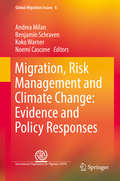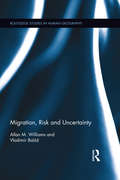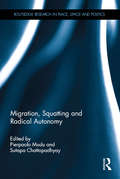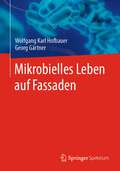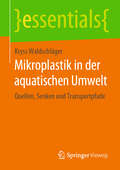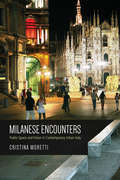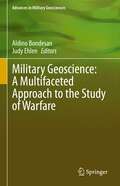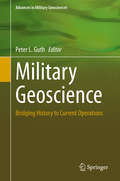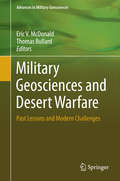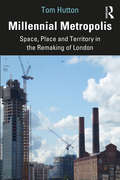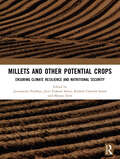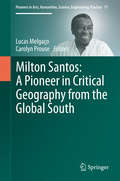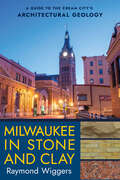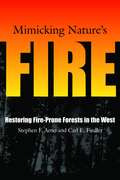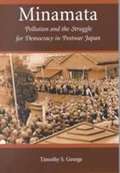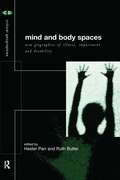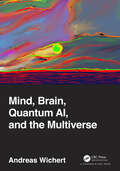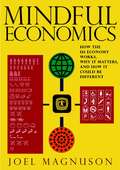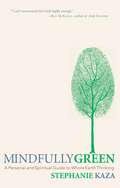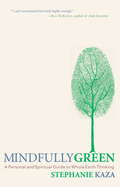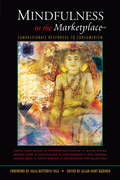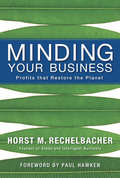- Table View
- List View
Migration, Risk Management and Climate Change: Evidence and Policy Responses
by Andrea Milan Benjamin Schraven Koko Warner Noemi CasconeThis edited volume explores the circumstances under which vulnerable communities can better adapt to climate and environmental change, and focuses in particular on the centrality of migration as a resilience and adaptation strategy for communities at risk. The book features important case studies where migration is being used as a risk management strategy in the Pacific, Sub-Sahara Africa, Latin America, and Europe. Its comparative analysis reveals common patterns in enhancing local resilience through migration across diverse regional, socio-economic, cultural, and political contexts. This book is a contribution to the global discussion about the future of migration policy, especially as climate and environmental change is expected to grow as one of the most pressing challenges of our time.
Migration, Risk and Uncertainty (Routledge Studies in Human Geography #53)
by Allan M. Williams Vladimír BalážMigration is one of the driving forces of economic and social change in the modern world. It is both informed by risk and a generator of risk, whether for individuals, households, communities or societies. Although the relationship between migration and risk is widely acknowledged, it has long been neglected in academic research, with a few exceptions such as household diversification strategies. Instead, risk is assumed to be implicit in economic or social models, rather than being explicitly theorised or analysed. This book represents the first major review of these key relationships. It draws on a wide range of theories - from economics, psychology, sociology, anthropology and geography - and an equally broad range of empirical material, to provide a highly original overview.
Migration, Squatting and Radical Autonomy: Resistance and Destabilization of Racist Regulatory Policies and B/Ordering mechanisms (Routledge Research in Place, Space and Politics)
by Pierpaolo Mudu Sutapa ChattopadhyayThis book offers a unique contribution, exploring how the intersections among migrants and radical squatter’s movements have evolved over past decades. The complexity and importance of squatting practices are analyzed from a bottom-up perspective, to demonstrate how the spaces of squatting can be transformed by migrants. With contributions from scholars, scholar-activists, and activists, this book provides unique insights into how squatting has offered an alternative to dominant anti-immigrant policies, and the implications of squatting on the social acceptance of migrants. It illustrates the different mechanisms of protest followed in solidarity by migrant squatters and Social Center activists, when discrimination comes from above or below, and explores how can different spatialities be conceived and realized by radical practices. Contributions adopt a variety of perspectives, from critical human geography, social movement studies, political sociology, urban anthropology, autonomous Marxism, feminism, open localism, anarchism and post-structuralism, to analyze and contextualize migrants and squatters’ exclusion and social justice issues. This book is a timely and original contribution through its exploration of migrations, squatting and radical autonomy.
Mikrobielles Leben auf Fassaden
by Georg Gärtner Wolfgang Karl HofbauerArchitekten, Bauingenieure, Bausachverständige und andere Fachleute sowie Bauherren, Wissenschaftler und Masterstudenten finden in diesem Buch alle Informationen zu Fassadenalgen und -pilzen. Es gibt einen detaillierten Überblick über die Mikroorganismen, die das anfängliche Wachstum an den Außenfassaden von Gebäuden bilden und befasst sich mit den ökophysiologischen Eigenschaften, die die Rahmenbedingungen charakterisieren, unter denen diese Mikroorganismen an Fassaden auftreten können. Neben einem Bestimmungsschlüssel für die charakteristischen Anflüge an Fassaden von Mikroorganismen enthält dieses Buch eine ausführliche Beschreibung der einzelnen Organismen unter Angabe ihres ökologischen Verbreitungsgebiets. Darüber hinaus werden die verschiedenen ökologischen Parameter in kurzen Kapiteln diskutiert. Auch Maßnahmen zur Vorbeugung und Bekämpfung der Besiedelung von Fassaden mit Mikroorganismen werden thematisiert.
Mikromagnetische Charakterisierung des Ermüdungsverhaltens und der Eigenspannungsrelaxation tiefgebohrter Proben des Vergütungsstahls 42CrMo4 (Werkstofftechnische Berichte │ Reports of Materials Science and Engineering)
by Nikolas BaakNikolas Baak befasst sich mit der Qualifizierung mikromagnetischer Methoden zur Bewertung der durch Tiefbohren erzeugten Randzonen hinsichtlich ihrer Oberflächenintegrität und deren Einfluss auf das Ermüdungsverhalten. Dabei wird das Ziel verfolgt, durch den Bohrprozess einen vorteilhaften Eigenspannungszustand zu erreichen. Beim hier eingesetzten Einlippen-Tiefbohren kommt es aufgrund des asymmetrischen Werkzeugaufbaus zu einer Art Festwalzprozess. Dadurch werden sowohl sehr hohe Oberflächengüten, als auch der gewünschte Druckeigenspannungszustand erzeugt. Da die meisten Verfahren zur Bestimmung der Oberflächenintegrität entweder zerstörend sind oder auch einen freien Zugang zur Oberfläche benötigen, werden hier zerstörungsfreie Prüfverfahren dafür ertüchtigt, die Oberflächenintegrität sowie den Ermüdungszustand der Bauteile zu bestimmen. Für beide hier betrachteten mikromagnetischen Verfahren, einerseits die Barkhausenrauschen-Analyse und andererseits die Wirbelstromprüfung, werden speziell angefertigte Sensoren, welche das Messsignal an der Innenseite der Bohrung detektieren können, verwendet. Die Messdaten der mikromagnetischen Verfahren werden mit den etablierten Verfahren zur Bestimmung der Oberflächenintegrität, wie bspw. Röntgendiffraktometrie, korreliert.
Mikroplastik in der aquatischen Umwelt: Quellen, Senken und Transportpfade (essentials)
by Kryss WaldschlägerMikroplastik ist derzeit ein allgegenwärtiges Thema in den Medien und wird daher auch in der Bevölkerung als umweltrelevante Problematik wahrgenommen. Da jedoch viel Halbwissen zur Meinungsbildung beiträgt, bereitet dieses essential den aktuellen Forschungstand auf und stellt ihn allgemein verständlich dar. Angefangen bei den Grundlagen der Mikroplastikdefinition und den derzeit bekannten Quellen über bisher nachgewiesene Konzentrationen in der aquatischen Umwelt bis hin zu den Senken wird der Weg des Mikroplastiks durch die Gewässer dieser Erde beschrieben. Abschließend wird auf die Umweltrisiken, die Mikroplastik für die Ökosysteme, die aquatischen Organismen und den Menschen birgt, eingegangen. Dabei werden viele Wissenslücken aufgezeigt, die zukünftig geschlossen werden müssen und die innerhalb der üblicherweise kurzen Beiträge in Massenmedien so nicht präsentiert werden.Die Autorin: Kryss Waldschläger hat Bauingenieurwesen studiert und arbeitet derzeit als wissenschaftliche Mitarbeiterin am Institut für Wasserbau und Wasserwirtschaft der RWTH Aachen University. Dort untersucht sie im Rahmen ihrer Promotion das Transportverhalten von Mikroplastik in Fließgewässern.
Milanese Encounters
by Cristina MorettiIn a city driven by fashion and design, visibility and invisibility are powerful forces. Milanese Encounters examines how the acts of looking, recognizing, and being seen reflect social relations and power structures in contemporary Milan.Cristina Moretti's ethnographic study reveals how the meanings of Milan's public spaces shift as the city's various inhabitants use, appropriate, and travel through them. Moretti's extensive fieldwork covers international migrants, social justice organizations, and middle-class citizens groups in locations such as community centers, abandoned industrial areas, and central plazas and streets. Situated at the intersection of urban and visual anthropology, her work will challenge and inspire scholars in anthropology, urban studies, and other fields.Contributing to studies of urban Italy, neoliberalism, and immigration, Milanese Encounters is a welcome demonstration of ethnography's potential to analyse the connections and divisions created by complex modern cities.
Military Geoscience: A Multifaceted Approach to the Study of Warfare (Advances in Military Geosciences)
by Judy Ehlen Aldino BondesanThis volume presents a selection of papers from the 13th International Conference on Military Geosciences (ICMG), held 24-28 June 2019 in Padua, Italy. It covers a wide range of subjects within the confines of military geoscience written by scientists with a variety of different backgrounds from many countries throughout the world. Many of the papers focus on subjects related to Italy and World War I, but additional subject areas include international perspectives in the military geosciences, international security, geospatial intelligence and remote sensing, subterranean and underground warfare, analyses of historical battlefields and fortifications, and military archaeology. The book will be of interest to academics (e.g., military historians, military archaeologists, military geographers and geologists), applied geoscientists (e.g., engineering geologists and geologists working in other areas of applied geology), professional geoscientists, and those with a general interest in military geoscience and history.
Military Geoscience: Bridging History to Current Operations (Advances in Military Geosciences)
by Peter L. GuthThis book is a collection of papers presented at the 11th International Conference of Military Geoscience that was held in 2015. The conference included discussion on a diverse range of geosciences, including military history, military geology, teaching geology from a military prospective, geological influence on the battlefield, and environmental and cultural issues related to management of military lands. Geology and geography have played a significant role in military history, from providing the stone for primitive tools and weapons, to the utilization of terrain in offensive and defensive strategies. Specific to this volume, deserts comprise nearly a third of the Earth’s surface and have been the site of numerous battles where the dust, heat, and a lack of food and water have provided challenges to military leaders and warriors. This book examines the role of deserts in past and modern warfare, the problems and challenges in managing military lands in desert regions, and how desert environmental conditions can impact military equipment and personnel. This proceedings volume should be of interest to scholars, professionals, and those interested in military history, warfare, geology, geography, cultural resources, general science, and military operations.
Military Geosciences and Desert Warfare
by Eric V. Mcdonald Thomas BullardThis book is a collection of papers presented at the 9th International Conference of Military Geoscience that was held in 2011. The conference included discussion on a diverse range of geosciences, including military history, military geology, teaching geology from a military prospective, geological influence on the battlefield, and environmental and cultural issues related to management of military lands. Geology and geography have played a significant role in military history, from providing the stone for primitive tools and weapons, to the utilization of terrain in offensive and defensive strategies. Specific to this volume, deserts comprise nearly a third of the Earth's surface and have been the site of numerous battles where the dust, heat, and a lack of food and water have provided challenges to military leaders and warriors. This book examines the role of deserts in past and modern warfare, the problems and challenges in managing military lands in desert regions, and how desert environmental conditions can impact military equipment and personnel. This proceedings volume should be of interest to scholars, professionals, and those interested in military history, warfare, geology, geography, cultural resources, general science, and military operations.
Millennial Metropolis: Space, Place and Territory in the Remaking of London
by Tom HuttonThe text offers a critical perspective on complex and consequential aspects of growth and change in London, viewed through the lens of multiscalar space and brought to life through exemplary case studies. It demonstrates how capital, culture and governance have combined to reproduce London, within a frame of relational geographies and historical relayering. Emphasis is placed on the sequences of political change, capital intensification, industrial restructuring and cultural infusions which have transformed space in London since the 1980s. Tom Hutton contributes to the rich discourse on London’s experiences of urbanization, by producing a fresh perspective on its development saliency. Millennial Metropolis includes a systematic review and synthesis of research literatures on globalizing cities, with reference to the reproduction of space at the metropolitan, district and neighbourhood scales. Hutton offers a nuanced treatment of geographical scale, observed in the blending of global/transnational processes with the fine-grained imprint of governance processes and social relations. These proccesses are manifested in sites of innovation, spectacle and social conviviality, but also produce experiences of displacement and inequality. The author presents a spatial model of metropolitan development by exploring how growth and change in twenty-first-century London is expressed internally as an enlarged zonal structure extending beyond the traditional territories of central and inner London. Serious threats to London are discussed —from the isolating implications of Brexit, the impact of the Covid-19 pandemic and the dire threat of ecological crises and deteriorating public health associated with climate change. This will be an invaluable text for postgraduate students, established scholars and upper level undergraduates, across diverse disciplines and fields including geography, sociology, governance studies and planning and urban studies.
Millets Value Chain for Nutritional Security
by B. Dayakar Rao N. G. Malleshi George A. Annor J. V. PatilThe development of successful value chains to revive demand for traditional cereals such as millets plays an important role in ensuring health and nutrition security in India. Millets Value Chain for Nutritional Security: A Replicable Success Model from India demonstrates value addition to millets from production to consumption, covering chapters on nutritional evaluation, on-farm cultivation, intervention in food processing, entrepreneurship development, commercialization and popularization and policy sensitization. This book outlines practical interventions to revive the demand for millets as a convenient and nutritive option for consumers, while presenting a reliable model that can be adapted for the development of other commodities.
Millets Value Chain for Nutritional Security: A Replicable Success Model from India
by Jagannath Vishnu Patil Dr Benhur Dayakar Rao N G Malleshi George A AnnorThis book demonstrates a successful and sustainable model for value addition to millets from production to consumption. Within the work the authors outline practical interventions to revive the demand for millets as a convenient and nutritive option for consumers, whilst presenting a reliable model that can be adapted for the development of other commodities. Based on practical experience and the output of a National Agricultural Innovation Project, Millets Value Chain for Nutritional Security: A Replicable Success Model from India explores the development of an integrated approach to value addition to millets. All phases of the model are covered, including chapters on: · nutritional evaluation · on-farm cultivation · intervention in food processing · entrepreneurship development · commercialization · popularization and policy sensitization. The development of successful value chains to revive demand for traditional cereals such as millets plays an important role in ensuring health and nutrition security in India. As such, this book is an invaluable resource for researchers and advanced students in the fields of agriculture, food science and business management, in addition to policy makers, manufacturers and breeders.
Millets and Other Potential Crops: Ensuring Climate Resilience and Nutritional Security
by Jyoti Prakash Sahoo Jyostnarani Pradhan Manasi Dash Kailash Chandra SamalDeeply rooted in indigenous peoples’ culture and traditions, millets (also called ‘nutricereals’ are ancestral crops high in nutritional value. As the global agrifood systems face challenges to feed an ever-growing global population, resilient cereals like millets provide an affordable and nutritious option and help guarantee food security.This book presents the basic principles and practices of millets and other potential crops towards climate resilience and nutritional security. It discuses the role of millets in sustainable agriculture, the medicinal use of foxtail millet, exotic fruits in India, and climate-resilient fruit and vegetable crops.The goal of this work is to promote the sustainable cultivation of millets, also under adverse and changing climatic conditions and improving their quality, highlighting their potential to provide new sustainable market opportunities for producers and consumers.Print edition not for sale in South Asia (India, Sri Lanka, Nepal, Bangladesh, Pakistan or Bhutan)
Milton Santos: A Pioneer in Critical Geography from the Global South
by Lucas Melgaço Carolyn ProuseFor decades, Milton Santos (1926-2001) has been considered one of the most influential thinkers in Brazilian and Latin American social sciences and geography. Yet his writings, most of which have not been translated into English, are largely unknown to European and North American audiences. This book introduces English-speaking scholars to Professor Santos through critical engagement with his ideas and writings. The chapters presented here reveal the breadth and originality of his critical thought, as well as its ongoing importance to contemporary debates. The book features a biography of Santos and includes an annotated translation of one of his most-cited texts, The Return of the Territory, offered here for the first time in English. This text demonstrates how Santos's provocative insights continue to transform core concepts of political and human geography. The book also includes a number of short chapters written by scholars from Brazil, Spain and France. Through reflections on Santos's work, the various authors demonstrate the value and possibilities of extending the geographer's theories. They explore key geographical themes across political economy, rural studies, territorial planning, environmental crisis, digital networks, indigenous peoples, transportation and public health. This collection invites geographers from around the world to engage with this rich intellectual tradition from Brazil.
Milwaukee in Stone and Clay: A Guide to the Cream City's Architectural Geology
by Raymond WiggersMilwaukee in Stone and Clay follows directly in the footsteps of Raymond Wiggers's previous award-winning book, Chicago in Stone and Clay. It offers a wide-ranging look at the fascinating geology found in the building materials of Milwaukee County's architectural landmarks. And it reveals the intriguing and often surprising links between science, art, and engineering. Laid out in two main sections, the book first introduces the reader to the fundamentals of Milwaukee's geology and its amazing prehuman history, then provides a site-by-site tour guide. Written in an engaging, informal style, this work presents the first in-depth exploration of the interplay among the region's most architecturally significant sites, the materials they're made of, and the sediments and bedrock they're anchored in. Raymond Wiggers crafted Milwaukee in Stone and Clay as an informative and exciting overview of this city. His two decades of experience leading architectural-geology tours have demonstrated the popularity of this approach and the subject matter.
Mimicking Nature's Fire: Restoring Fire-Prone Forests In The West
by Carl E. Fiedler Stephen F. ArnoIn Mimicking Nature's Fire, forest ecologists Stephen Arno and Carl Fiedler present practical solutions to the pervasive problem of deteriorating forest conditions in western North America.
Minamata: Pollution and the Struggle for Democracy in Postwar Japan
by Timothy S. GeorgeNearly forty years after the outbreak of the “Minamata Disease,” it remains one of the most horrific examples of environmental poisoning. Based on primary documents and interviews, this book describes three rounds of responses to this incidence of mercury poisoning, focusing on the efforts of its victims and their supporters, particularly the activities of grassroots movements and popular campaigns, to secure redress.
Mind and Body Spaces: Geographies of Illness, Impairment and Disability (Critical Geographies #Vol. 1)
by Hester Parr Ruth ButlerMind and Body Spaces highlights new international research from Britain, USA, Canada and Australia, on bodily impairment, mental health and disabled peoples social worlds. The contributors discuss a variety of current issues including:* historical conceptions of the body and behaviour* contemporary political activism* matters of identity and employment* accessible housing* parenthood and child carers* psychiatric medication use* masculinity and sexuality* autobiography* social exclusion and inclusion. The contributors are: Hester Parr, Ruth Butler, Rob Imrie, Michael L. Dorn, Deborah Carter Park, John Radford, Brendan Gleeson, Isabel Dyck, Edward Hall, Pamela Moss, Gill Valentine, Christine Milligan, Flora Gathorne-Hardy, Jane Stables, Fiona Smith and Vera Chouinard.
Mind, Brain, Quantum AI, and the Multiverse
by Andreas WichertMind, Brain, Quantum AI, and the Multiverse There is a long-lasting controversy concerning our mind and consciousness.This book proposes a connection between the mind, the brain, and the multiverse. The author introduces the main philosophical ideas concerning mind and freedom, and explains the basic principles of computer science, artificial intelligence of brain research, quantum physics, and quantum artificial intelligence. He indicates how we can provide an answer to the problem of the mind and consciousness by describing the nature of the physical world. His proposed explanation includes the Everett Many-Worlds theory. Mind, Brain, Quantum AI, and the Multiverse tries to avoid any non-essential metaphysical speculations. The book is an essential compilation of knowledge in philosophy, computer science, biology, and quantum physics. It is written for readers without any requirements in mathematics, physics, or computer science.
Mindful Economics: How the U.S. Economy Works, Why it Matters, and How it Could Be Different
by Joel MagnusonAre the huge profits garnered by corporations each year a case of a few bad apples in the business world taking advantage of unmonitored dealings? Is this consolidation of wealth made at the expense of the overall economy and the wellbeing of the average citizen? Will the planet be saved by developing more "green businesses" and "green collar" jobs? Joel Magnuson delivers a powerful response to the current misconceptions about the US economy in his brilliantly accessible Mindful Economics. The troubles we face are not the result of a good system gone awry, but rather a system that is built to do exactly what it is doing: corporations are designed to reap profits for its shareholders, at any cost. The greater welfare of society, or of the environment, will never be as important as financial gain. Magnuson shows us the relationship between the current wars abroad; rising oil prices; the recession; ballooning incomes of top CEOs; the mortgage crisis; and the health care, insurance, and auto industries, and he teaches us that the best way to understand the US economy is to think like an economist. With stunning clarity, Magnuson shows the interconnectedness of the local with the global, and offers real alternatives to this capitalist model.
Mindfully Green: A Personal and Spiritual Guide to Whole Earth Thinking
by Stephanie KazaWith all the attention on living sustainably, the one thing missing from the conversation is how to find a personal connection with green living that will sustain us on our green path. While practical approaches to an eco-responsible lifestyle offer important first steps, it is critical that we ground these actions in broader understanding so that we can effect real change in the world. In this book, Stephanie Kaza describes what she calls the "green practice path. " She offers a simple, Buddhist-inspired philosophy for taking up environmental action in real, practical, and effective ways. Discover new ways to think more deeply about your impact on the natural world, engage in environmental change, and make green living a personal practice based in compassion and true conviction.
Mindfully Green: A Personal and Spiritual Guide to Whole Earth Thinking
by Stephanie KazaWith all the attention on living sustainably, the one thing missing from the conversation is how to find a personal connection with green living that will sustain us on our green path. While practical approaches to an eco-responsible lifestyle offer important first steps, it is critical that we ground these actions in broader understanding so that we can effect real change in the world. In this book, Stephanie Kaza describes what she calls the "green practice path." She offers a simple, Buddhist-inspired philosophy for taking up environmental action in real, practical, and effective ways. Discover new ways to think more deeply about your impact on the natural world, engage in environmental change, and make green living a personal practice based in compassion and true conviction.
Mindfulness in the Marketplace: Compassionate Responses to Consumerism
by Julia Hill Allan Hunt BadinerMindfulness in the Marketplace suggests a reorientation of consumers from passive purchasers to aware, responsible citizens who see the dynamic connection between their purchases and their values. The Middle Path of Buddhism is not to avoid all consumption, but to consume mindfully in a manner that protects ourselves and all living systems. This anthology outlines a path of compassionate resistance to global corporatization, and offers a view of getting into right relationship with the Earth. Includes the Dalai Lama, Thich Nhat Hanh, Stephen Batchelor, and Joanna Macy.
Minding Your Business
by Paul Hawken Horst RechelbacherThe business world is at a crisis point- the bubble is going to burst soon. New ways of doing business have to be found. We can't keep repeating the past or the present. Rechelbacher contends that the biggest business opportunities for the next century will come from practicing environmentally sound, sustainable business that is in harmony with the rhythms of the natural world. The first step in this process is aligning ourselves with the natural world. By managing our personal lives as if they were corporations and putting them in line with what we observe in nature, we will be able to align our businesses with the environment as well, reaping the rewards of a healthy, sustainable abundance.
